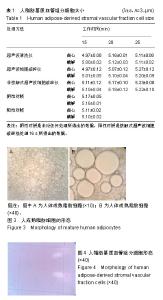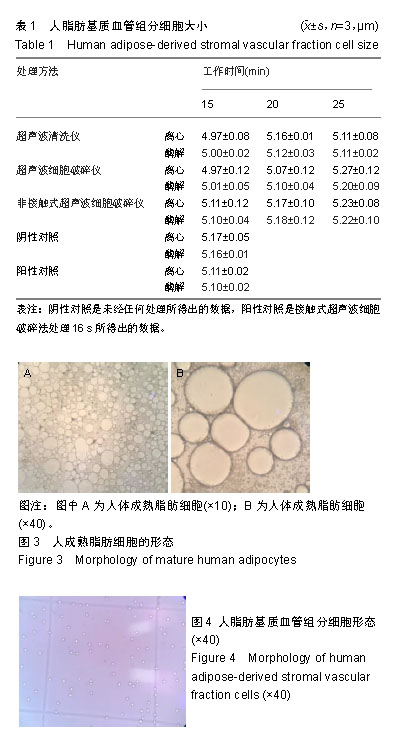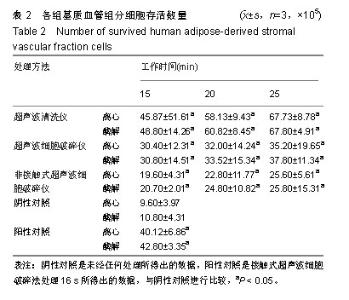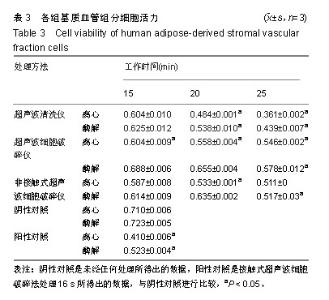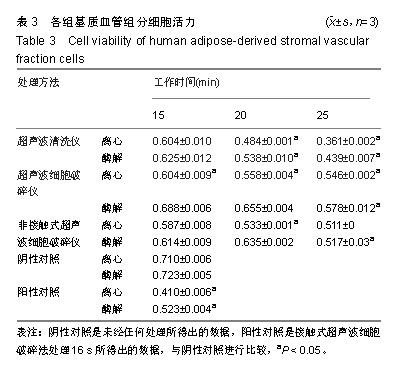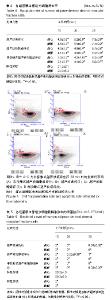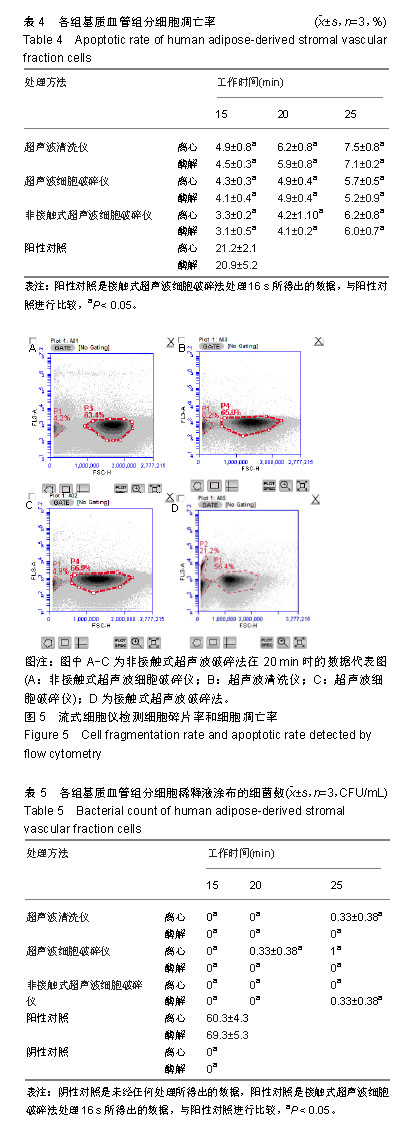| [1]Friedenstein AJ, Petrakova KV, Kurolesova AI, et al. Heterotopic of bone marrow. Analysis of precursor cells for osteogenic and hematopoietic tissues. Transplantation.1968;6(2):230-247.[2]Heo JS, Choi Y, Kim HS, et al. Comparison of molecular profiles of human mesenchymal stem cells derived from bone marrow, umbilical cord blood, placenta and adipose tissue. Int J Mol Med. 2016;37(1): 115-125.[3]Xiong BJ, Tan QW, Chen YJ, et al. The Effects of Platelet-Rich Plasma and Adipose-Derived Stem Cells on Neovascularization and Fat Graft Survival. Aesthetic Plast Surg. 2018;42(1):1-8.[4]Zhang Y, Cai J, Zhou T, et al. Improved Long-Term Volume Retention of Stromal Vascular Fraction Gel Grafting with Enhanced Angiogenesis and Adipogenesis. Plast Reconstr Surg.2018;141(5):676e-686e.[5]Rodbell M.Metabolism of isolated fat cells. i. effects of hormones on glucose metabolism and lipolysis. J Biol Chem.1964;239:375-380.[6]Zuk PA, Zhu M, Mizuno H, et al. Multilineage cells from human adipose tissue: implications for cell-based therapies.Tissue Eng. 2001;7(2): 211-228.[7]Gaiba S, França LP, França JP, et al. Characterization of human adipose-derived stem cells. Acta Cir Bras. 2012;27(7):471-476.[8]Yao Y, Dong Z, Liao Y, et al. Adipose Extracellular Matrix/Stromal Vascular Fraction Gel: A Novel Adipose Tissue-Derived Injectable for Stem Cell Therapy. Plast Reconstr Surg. 2017;139(4):867-879.[9]Garza RM, Rennert RC, Paik KJ, et al. Studies in fat grafting: Part IV. Adipose-derived stromal cell gene expression in cell-assisted lipotransfer. Plast Reconstr Surg. 2015;135(4):1045-1055.[10]Paik KJ, Zielins ER, Atashroo DA, et al. Studies in Fat Grafting: Part V. Cell-Assisted Lipotransfer to Enhance Fat Graft Retention Is Dose Dependent. Plast Reconstr Surg. 2015;136(1):67-75.[11]Gimble JM, Katz AJ, Bunnell BA. Adipose-derived stem cells for regenerative medicine. Circ Res. 2007;100(9):1249-1260.[12]Nie C, Yang D, Xu J, et al. Locally administered adipose-derived stem cells accelerate wound healing through differentiation and vasculogenesis. Cell Transplant. 2011;20(2):205-216.[13]Shah FS, Wu X, Dietrich M, et al. A non-enzymatic method for isolating human adipose tissue-derived stromal stem cells. Cytotherapy. 2013; 15(8):979-985.[14]刘洋,潘磊,金永利.鼠脂肪干细胞体外培养及软骨分化的研究[J].临床医药文献电子杂志, 2018,5(86):188.[15]Tonnard P, Verpaele A, Peeters G, et al. Nanofat grafting: basic research and clinical applications. Plast Reconstr Surg. 2013;132(4): 1017-1026.[16]Premaratne GU, Ma LP, Fujita M, et al. Stromal vascular fraction transplantation as an alternative therapy for ischemic heart failure: anti-inflammatory role. J Cardiothorac Surg. 2011;6:43.[17]Brennen CE. Cavitation and Bubble Dynamics. Oxford: Oxford University Press,1995.[18]Zhu J, Wang Y, Li X, et al. Combined effect of ultrasound, heat, and pressure on Escherichia coli O157:H7, polyphenol oxidase activity, and anthocyanins in blueberry (Vaccinium corymbosum) juice. Ultrason Sonochem. 2017;37:251-259.[19]Ferrario M, Guerrero S. Impact of a combined processing technology involving ultrasound and pulsed light on structural and physiological changes of Saccharomyces cerevisiae KE 162 in apple juice. Food Microbiol. 2017;65:83-94.[20]Yang YH , Lin SY . Medical ultrasonic treatment and its applications in medicine[C].上海:2012全国压电和声波理论及器件技术研讨会论文集, 2012.[21]Leonov GV, Khmelev VN, Barsukov RV, et al. Increasing of ultrasonic technologies efficiency and development of ultrasonic devices for industry, medicine and agriculture. International Siberian Workshop on Electron Devices and Materials,2004.[22]Kokhuis T, Skachkov I, Naaijkens B, et al. Characterization of microbubble-loaded stem cells for targeted cell therapy. IEEE International Ultrasonics Symposium, 2013:1146-1149.[23]Garbern JC, Lee RT. Cardiac stem cell therapy and the promise of heart regeneration. Cell Stem Cell. 2013;12(6):689-698.[24]Micu R, Chicea AL, Bratu DG, et al. Ultrasound and magnetic resonance imaging in the prenatal diagnosis of open spina bifida. Med Ultrason. 2018;20(2):221-227.[25]Cen LP, Ng TK.Stem cell therapy for retinal ganglion cell degeneration. Neural Regen Res. 2018;13(8):1352-1353.[26]龚军辉,王晶.稀释涂布平板法计数活菌的方法简介[J].生物学教学, 2018, 43(2):70-71.[27]Majka SM, Miller HL, Helm KM, et al. Analysis and isolation of adipocytes by flow cytometry. Methods Enzymol. 2014;537:281-296.[28]Boumelhem BB, Assinder SJ, Bell-Anderson KS, et al. Flow cytometric single cell analysis reveals heterogeneity between adipose depots. Adipocyte. 2017;6(2):112-123.[29]马晨光,薛迪.干细胞研究与应用的伦理问题、伦理规范与伦理实证研究[J].中国医学伦理学,2019,32(1):26-29.[30]Pierantozzi E, Badin M, Vezzani B, et al. Human pericytes isolated from adipose tissue have better differentiation abilities than their mesenchymal stem cell counterparts. Cell Tissue Res. 2015;361(3):769-778.[31]Fan J, Sun Z. The Antiaging Gene Klotho Regulates Proliferation and Differentiation of Adipose-Derived Stem Cells. Stem Cells. 2016;34(6): 1615-1625.[32]王延光.人类胚胎干细胞的来源与伦理思考[J].医学与哲学,2002,23(2):7-10.[33]Sterodimas A, de Faria J, Nicaretta B, et al. Tissue engineering with adipose-derived stem cells (ADSCs): current and future applications. J Plast Reconstr Aesthet Surg. 2010;63(11):1886-1892.[34]Roxburgh J, Metcalfe AD, Martin YH. The effect of medium selection on adipose-derived stem cell expansion and differentiation: implications for application in regenerative medicine. Cytotechnology. 2016;68(4):957-967.[35]Chen D, Liu S, Ma H, et al. Paracrine factors from adipose- mesenchymal stem cells enhance metastatic capacity through Wnt signaling pathway in a colon cancer cell co-culture model. Cancer Cell Int. 2015;15:42.[36]Sun M, He Y, Zhou T, et al. Adipose Extracellular Matrix/Stromal Vascular Fraction Gel Secretes Angiogenic Factors and Enhances Skin Wound Healing in a Murine Model. Biomed Res Int. 2017;2017: 3105780.[37]Schendel SA. Autologous Adipose-Derived Tissue Matrix Part I: Biologic Characteristics. Aesthet Surg J. 2017;37(9):1062-1068.[38]Priglinger E, Schuh CMAP, Steffenhagen C, et al. Improvement of adipose tissue-derived cells by low-energy extracorporeal shock wave therapy. Cytotherapy. 2017;19(9):1079-1095. |
